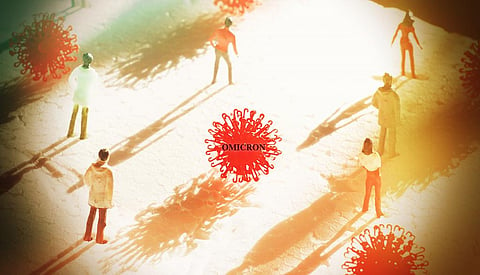

The data of the first four weeks of novel coronavirus disease (COVID-19) infections triggered by the new variant of concern (VoC), omicron, in Gauteng province of South Africa has indicated the infections caused by the variant were more contagious, but not so severe.
A new preprint published in The Lancet studied the clinical severity of the COVID-19 patients admitted to hospitals in Gauteng province during the fourth wave of COVID-19 pandemic triggered by omicron.
The study, however, warned:
“Since any combination of a less virulent virus, comorbidities, high immunity from prior infection(s) or vaccination may be important contributors to this clinical presentation, care should be taken in extrapolating this to other populations with different comorbidity profiles, prevalence of prior infection and vaccination coverage.”
Data of the first four weeks of the omicron outbreak was compared to that of the delta and beta outbreak for the same duration in the province. This was November 29-December 26, 2020 for the second wave caused by the beta variant; May 2-May 29, 2021 for the third wave caused by delta; and November 14-December 11, 2021 for the fourth wave caused by omicron.
As many as 41,046 cases were reported in the first month of the second wave; 33,423 cases were reported for the same duration in the third wave.
In comparison, 133,551 cases were reported in the first month of the fourth wave, confirming omicron’s high transmissibility. However, hospitalisation dropped significantly.
Nearly 8,000 of the 41,046 people who tested positive (18.9 per cent) for the virus in the second wave required hospitalisation, the study said. In the third wave, 4,574 of the 33,423 (13.7) per cent people were admitted to hospital.
In comparison, just 4.9 per cent of people who tested positive for the virus were hospitalised during the wave triggered by omicron. However, absolute figures were fairly high, at 6,510.
The study also explored the proportion of people who suffered severe disease out of those hospitalised in each wave. In the second wave, 60.1 per cent of the hospitalised population (4,672 out of 7,774) suffered severe disease.
In the third wave, 66.9 per cent (3,058 out of 4,574) suffered severe disease while 28.8 per cent of the hospitalised population suffered severe disease in the omicron wave.
Severe disease here is measured by several indicators, including acute respiratory distress, supplemental oxygen, mechanical ventilation, high or intensive care and death.
The need for oxygen supplementation also came down, from 39.4 per cent of patients in the second wave and 48.8 per cent in the third to just 19.7 per cent in the fourth wave.
Same goes for the average time spent in the hospital, which came down from seven and eight days in the second and third wave respectively, to four days in the fourth wave.
“The number of adults aged more than 20 years admitted to hospital was lower in the fourth wave compared to both past waves leading to lower clinical burdens in healthcare services even in the midst of a much higher number of SARS-CoV-2 cases,” the study noted.
There is, however, some worrying news too.
Omicron has infected a greater number of children and adolescents, the largely unvaccinated population, which is 17.7 per cent (1,151 out of 6,510). This figure was 3.9 per cent (306 out of 7,774) for the second wave and 3.5 per cent (161 out of 4,574) for the third.
Contrastingly, hospitalisation in this age group has more or less remained the same throughout each wave, coming down marginally during omicron infections at 22.5 per cent in the second wave, 23 per cent in the third and 20.4 per cent in the fourth wave.
It remains unclear why South Africa’s fourth wave has not been as severe as the preceding waves. The study noted that a high rate of prior delta infections, immunity from vaccination especially in the elderly and a less severe variant could be reasons behind this.
“An important consideration in the interpretation of these results is that they reflect only the early part of the waves prior to their peaks,” the study said, adding that these results may not necessarily paint the true picture of the severity of an omicron wave.
South Africa’s Gauteng province was the epicentre of the omicron outbreak. Cases began to spike in mid-November; by the end of the month, the World Health Organization declared omicron a VoC. Soon after, information began trickling on its immunity-evading and high transmissibility characteristics.